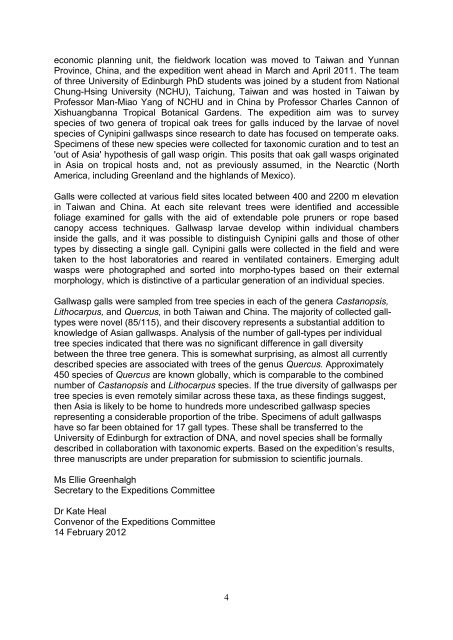Chapter 3 â Policy Implications for Gaelic - University of Edinburgh
Chapter 3 â Policy Implications for Gaelic - University of Edinburgh
Chapter 3 â Policy Implications for Gaelic - University of Edinburgh
Create successful ePaper yourself
Turn your PDF publications into a flip-book with our unique Google optimized e-Paper software.
economic planning unit, the fieldwork location was moved to Taiwan and Yunnan<br />
Province, China, and the expedition went ahead in March and April 2011. The team<br />
<strong>of</strong> three <strong>University</strong> <strong>of</strong> <strong>Edinburgh</strong> PhD students was joined by a student from National<br />
Chung-Hsing <strong>University</strong> (NCHU), Taichung, Taiwan and was hosted in Taiwan by<br />
Pr<strong>of</strong>essor Man-Miao Yang <strong>of</strong> NCHU and in China by Pr<strong>of</strong>essor Charles Cannon <strong>of</strong><br />
Xishuangbanna Tropical Botanical Gardens. The expedition aim was to survey<br />
species <strong>of</strong> two genera <strong>of</strong> tropical oak trees <strong>for</strong> galls induced by the larvae <strong>of</strong> novel<br />
species <strong>of</strong> Cynipini gallwasps since research to date has focused on temperate oaks.<br />
Specimens <strong>of</strong> these new species were collected <strong>for</strong> taxonomic curation and to test an<br />
'out <strong>of</strong> Asia' hypothesis <strong>of</strong> gall wasp origin. This posits that oak gall wasps originated<br />
in Asia on tropical hosts and, not as previously assumed, in the Nearctic (North<br />
America, including Greenland and the highlands <strong>of</strong> Mexico).<br />
Galls were collected at various field sites located between 400 and 2200 m elevation<br />
in Taiwan and China. At each site relevant trees were identified and accessible<br />
foliage examined <strong>for</strong> galls with the aid <strong>of</strong> extendable pole pruners or rope based<br />
canopy access techniques. Gallwasp larvae develop within individual chambers<br />
inside the galls, and it was possible to distinguish Cynipini galls and those <strong>of</strong> other<br />
types by dissecting a single gall. Cynipini galls were collected in the field and were<br />
taken to the host laboratories and reared in ventilated containers. Emerging adult<br />
wasps were photographed and sorted into morpho-types based on their external<br />
morphology, which is distinctive <strong>of</strong> a particular generation <strong>of</strong> an individual species.<br />
Gallwasp galls were sampled from tree species in each <strong>of</strong> the genera Castanopsis,<br />
Lithocarpus, and Quercus, in both Taiwan and China. The majority <strong>of</strong> collected galltypes<br />
were novel (85/115), and their discovery represents a substantial addition to<br />
knowledge <strong>of</strong> Asian gallwasps. Analysis <strong>of</strong> the number <strong>of</strong> gall-types per individual<br />
tree species indicated that there was no significant difference in gall diversity<br />
between the three tree genera. This is somewhat surprising, as almost all currently<br />
described species are associated with trees <strong>of</strong> the genus Quercus. Approximately<br />
450 species <strong>of</strong> Quercus are known globally, which is comparable to the combined<br />
number <strong>of</strong> Castanopsis and Lithocarpus species. If the true diversity <strong>of</strong> gallwasps per<br />
tree species is even remotely similar across these taxa, as these findings suggest,<br />
then Asia is likely to be home to hundreds more undescribed gallwasp species<br />
representing a considerable proportion <strong>of</strong> the tribe. Specimens <strong>of</strong> adult gallwasps<br />
have so far been obtained <strong>for</strong> 17 gall types. These shall be transferred to the<br />
<strong>University</strong> <strong>of</strong> <strong>Edinburgh</strong> <strong>for</strong> extraction <strong>of</strong> DNA, and novel species shall be <strong>for</strong>mally<br />
described in collaboration with taxonomic experts. Based on the expedition’s results,<br />
three manuscripts are under preparation <strong>for</strong> submission to scientific journals.<br />
Ms Ellie Greenhalgh<br />
Secretary to the Expeditions Committee<br />
Dr Kate Heal<br />
Convenor <strong>of</strong> the Expeditions Committee<br />
14 February 2012<br />
4






